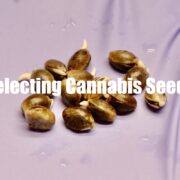Selecting Cannabis Seeds
Starting from seed begins with getting your hands on some. For many it starts when they find a seed in some flower they purchased and they go ahead and germinate it. Legendary strains have been and will continue to be born this way… but with the access to quality genetics and an incredible number of strains being crossed and crossed and crossed in the cannabis seed market today, the prospects for finding great genetics can turn previously reasonable people into obsessed collectors. So much of what drives breeding, seed production and consumption is that potential of what the mysterious little bean holds and how that idea sows itself into your mind. So where to go to find them? Well the internet mostly. Some states may allow sales of them in brick & mortar retail but online seed banks have proliferated in recent years in North America alongside the ongoing roll out of medical and recreational cannabis.
Some seed banks to get you started Neptune Seed Bank (US), Seeds Here Now (US), Deeply Rooted (US) Attitude Seed Bank (International) Seedsman Seed (Bank International)
Once you find a seed bank you like then it’s looking for a breeder. Or if you already have a breeder you like then it’s finding a seed bank that carries them. But finding a good seed bank gives you a working list of breeders to look at. Then you can research them on forums (like THCFarmer, OverGrow, 420Magazine), on web based strain guides (like Leafly) or their website if the breeder has one. Most of the breeders and seed banks have a social media presence on Instagram, which is where I’d recommend spending the most time digging into plant pics from the breeder’s customers. You can easily access pics all throughout people’s grows with the various strains you might be interested in. And you can often ask them questions and get responses as many growers love sharing their grow knowledge and experience. Choosing a breeder is pretty subjective in a lot of ways and there’s a lot of hype created around different strains and brands. But there’s also real benefits to choosing breeders who are working with proven genetics overtime and are testing their seeds before releasing widely.
A short list of some breeders to help get you started on your research. Exotic Genetix, Inhouse Genetics, Raw, Swamp Boy Seeds, Capulator, Humboldt, DNA, Relentless, Cannarado, Top Dawg, Thug Pug, 3rd Coast, Jinxproof, Cali Connection, Dynasty Genetics, Caper Purple, Raw Genetics, Mephisto Genetics (Autos), Night Owl (Autos)
Look around for cannabis seeds on a seed bank website and you’ll start seeing “Regular”, “Feminized” “Autoflower” and “Photoperiod” in the seed description. In short Regular means can be male or female. Feminized means bred to produce female plants only (hopefully, some increase in intersex traits (male flowers mixed in with female flowers) due to potential genetic instability from feminizing). That being said, mostly I have had good experiences with feminized seeds. Minimizing environmental stress is important with all plants but maybe just a bit more so with feminized seeds. Autoflower means the seed that plant produces is on a timer once it is germinated regardless of day/night length and will go through vegetative and flowering on a preset timeline, somewhere between 60-90 days from sprout to harvest. Photoperiod means that the plants vegetative and flowering phases are initiated by length of night/darkness. Once they hit 12hrs Day/12hrs Night flowering will begin. Growers can keep photoperiod plants in vegetatives states for as long as needed before flowering or continuously for growing mother plants to produce cuttings to start new cycles of the same strain. The timeline for photoperiod plants is usually measured as Flowering time and that usually falls somewhere in the 8-10 week range. Vegetative times vary as seeds can be flowered immediately or grown for weeks or months before flowering. As far a clones/cuttings are concerned, Photoperiods whether Regular or Feminized can produce cuttings. Autoflowers however, must be started from seed because even a cutting taken from an Auto already has a ticking biological clock that won’t be delayed. Both Photoperiods & Autoflowers can be Regular or Feminized. The difference is the effect of day length or darkness really and whether or not it is necessary to initiate flowering.
The last thing I’ll mention here is a valuable resource for looking up genetic lineages of strains you might be interested in trying. SeedFinder.EU is an incredible online reference for discovering the strains modern breeding has been created with and will continue to be built with indefinitely into the future. It can be pretty intimidating to navigate at first but can become an invaluable tool in figuring out what might be the next winner in your garden.



